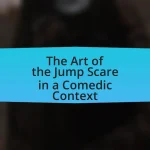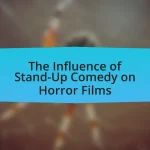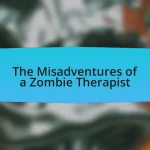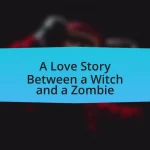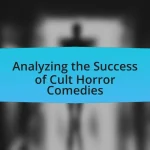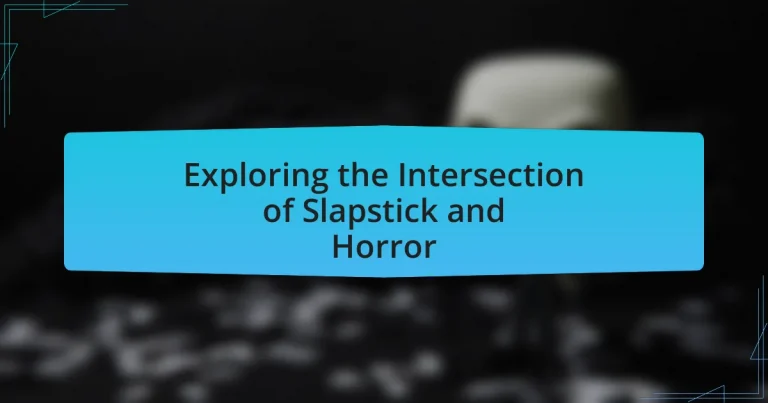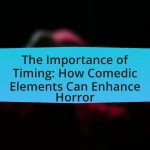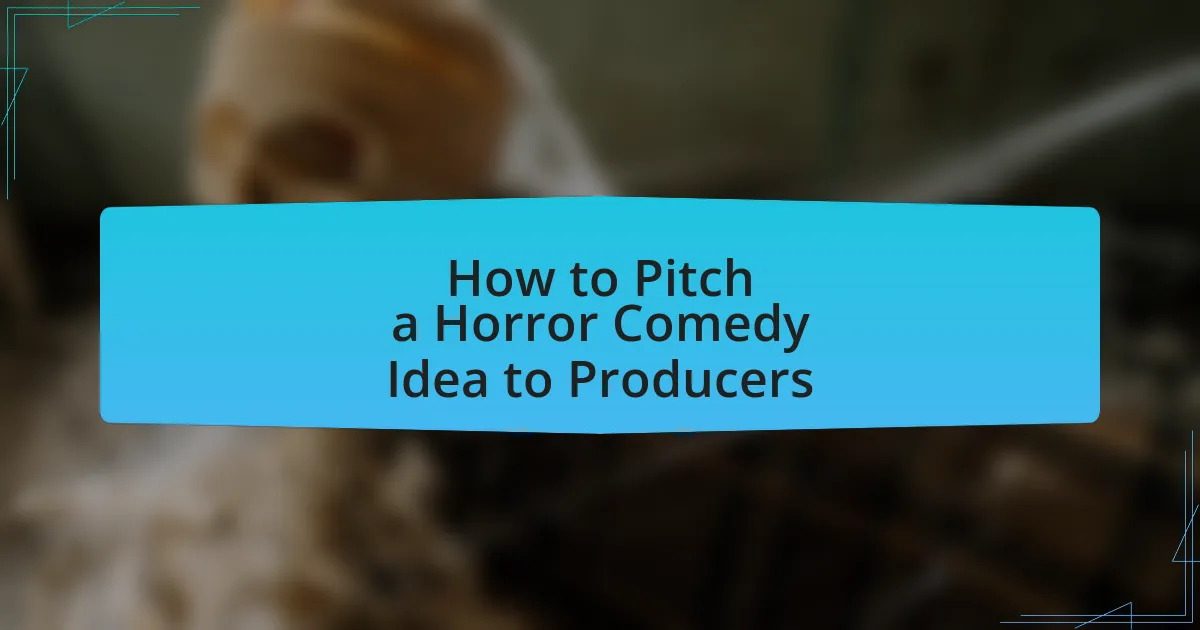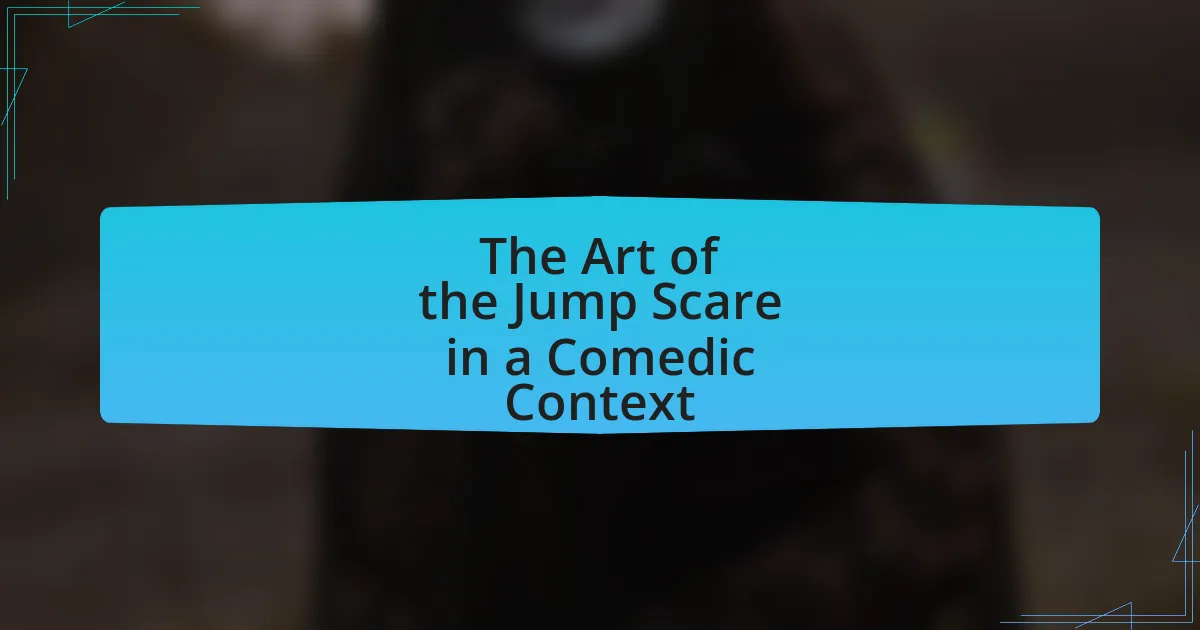The article explores the intersection of slapstick and horror, highlighting how the combination of comedic physical humor and elements of fear creates a unique viewing experience. It outlines the traditional differences between slapstick and horror genres, detailing their defining characteristics and emotional responses. The article also examines how slapstick techniques enhance horror, the psychological effects of humor in this context, and notable films that exemplify this blend, such as “Evil Dead II” and “Shaun of the Dead.” Additionally, it discusses the significance of timing, the role of cultural influences, and practical tips for filmmakers to effectively balance humor and horror in storytelling.
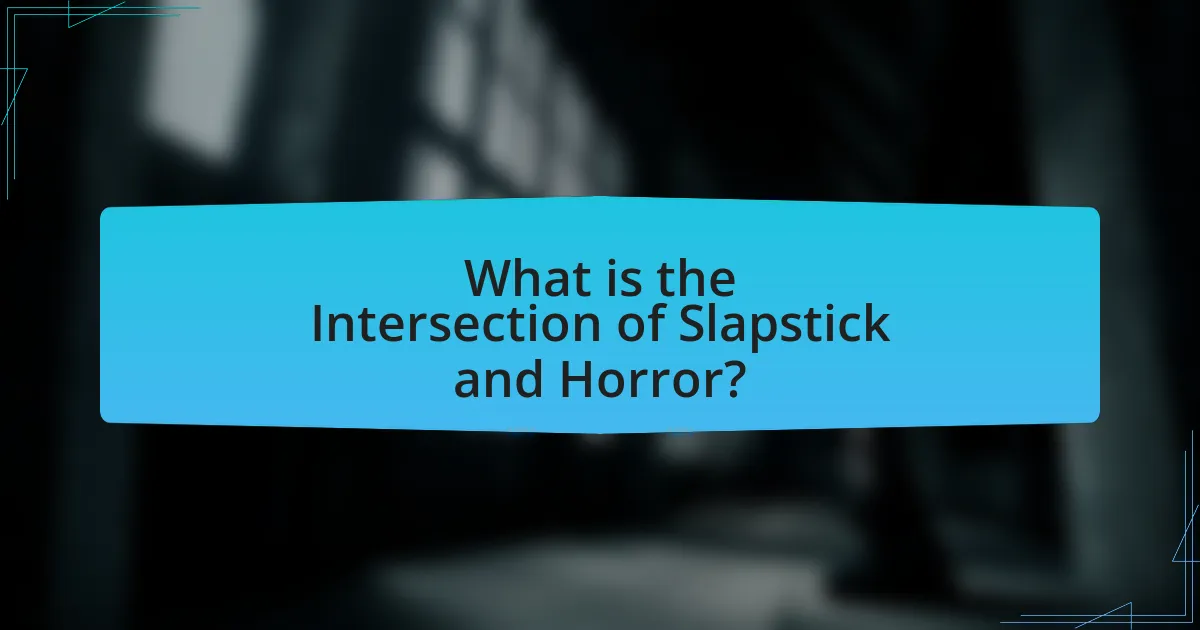
What is the Intersection of Slapstick and Horror?
The intersection of slapstick and horror occurs when comedic physical humor is combined with elements of fear and the macabre. This blend often utilizes exaggerated actions, absurdity, and visual gags typical of slapstick to create a juxtaposition against horror themes, resulting in a unique experience that elicits both laughter and fright. Films like “Evil Dead II” exemplify this intersection, where slapstick humor is employed alongside graphic horror, effectively engaging audiences through contrasting emotional responses.
How do slapstick and horror genres traditionally differ?
Slapstick and horror genres traditionally differ in their primary emotional responses and narrative techniques. Slapstick focuses on physical comedy, exaggerated actions, and humorous situations to elicit laughter, often featuring characters in absurd predicaments, as seen in classic films like “The Three Stooges.” In contrast, horror aims to provoke fear, suspense, and anxiety through dark themes, unsettling imagery, and tension-building narratives, exemplified by films like “Psycho.” The contrasting emotional goals—humor versus fear—highlight the fundamental differences in audience engagement and storytelling methods within these genres.
What are the defining characteristics of slapstick comedy?
Slapstick comedy is characterized by exaggerated physical actions, visual humor, and absurd situations. This genre often involves pratfalls, collisions, and other forms of physical mishaps that elicit laughter through their sheer absurdity and over-the-top execution. Historical examples include silent film stars like Charlie Chaplin and Buster Keaton, who utilized these elements to create memorable comedic moments. The effectiveness of slapstick lies in its ability to convey humor without the need for dialogue, relying instead on visual gags and physicality, which can be universally understood.
What are the defining characteristics of horror films?
Horror films are characterized by their ability to evoke fear, dread, and suspense in the audience. These films often utilize elements such as supernatural occurrences, psychological tension, and graphic violence to create an unsettling atmosphere. For instance, the use of suspenseful music and sudden jump scares heightens the emotional response, while themes of isolation and vulnerability are frequently explored, as seen in classics like “Psycho” and “The Shining.” Additionally, horror films often feature antagonists that embody societal fears, such as monsters or serial killers, which serve to reflect deeper anxieties within the culture.
Why is the intersection of slapstick and horror significant?
The intersection of slapstick and horror is significant because it creates a unique blend of humor and fear that can enhance audience engagement. This combination allows for the exploration of darker themes in a way that is accessible and entertaining, often subverting traditional horror tropes. For example, films like “Evil Dead II” utilize slapstick elements to provide comic relief amidst horror, making the terrifying moments more impactful. This interplay can also serve to critique societal norms and fears, as seen in works that juxtapose absurdity with violence, thereby inviting audiences to reflect on their own reactions to both genres.
How does combining these genres create unique storytelling opportunities?
Combining slapstick and horror creates unique storytelling opportunities by juxtaposing humor with fear, allowing for a dynamic exploration of human emotions. This blend enables creators to subvert audience expectations; for instance, moments of levity can provide relief from tension, making the horror elements more impactful. Historical examples, such as the film “Shaun of the Dead,” illustrate this technique effectively, as it uses comedic scenarios to enhance the horror experience, engaging viewers on multiple emotional levels. This interplay not only broadens the narrative scope but also invites diverse audience reactions, enriching the overall storytelling experience.
What cultural or historical contexts have influenced this intersection?
The intersection of slapstick and horror has been influenced by cultural contexts such as the evolution of silent film and the societal response to fear and humor. Silent films in the early 20th century, characterized by exaggerated physical comedy, laid the groundwork for slapstick, while horror films emerged as a response to societal anxieties, particularly during periods of war and economic instability. For instance, the 1920s saw the rise of horror films like “The Cabinet of Dr. Caligari,” which reflected post-World War I disillusionment, while slapstick comedies like those featuring Charlie Chaplin provided a counterbalance through humor. This duality illustrates how cultural fears can be juxtaposed with comedic relief, creating a unique blend that resonates with audiences.
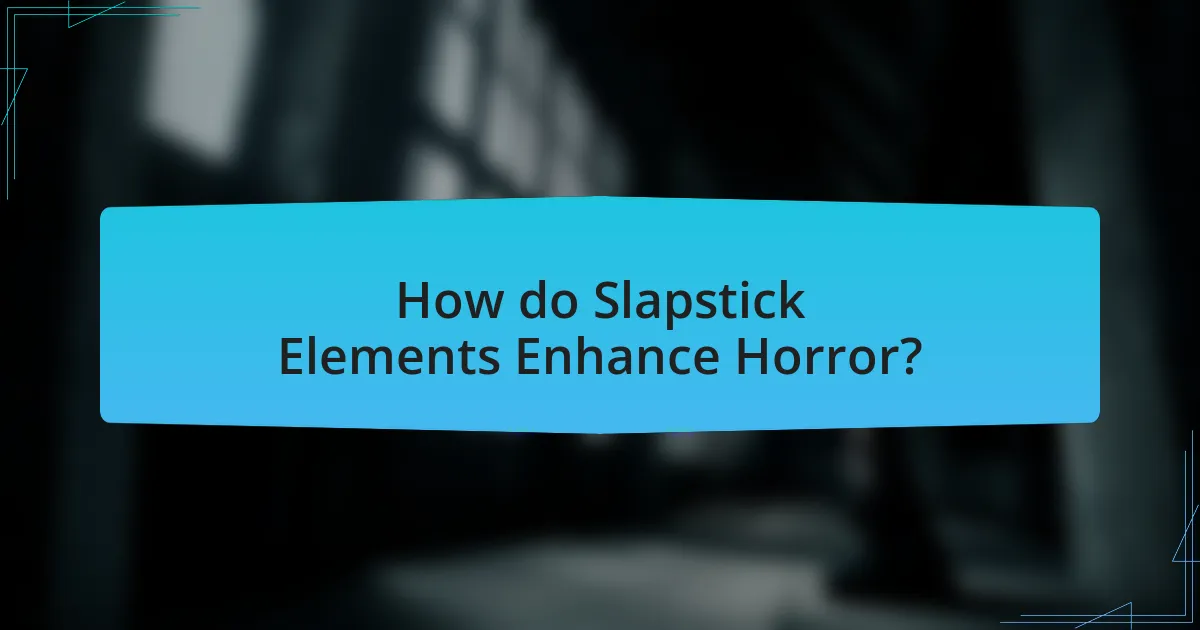
How do Slapstick Elements Enhance Horror?
Slapstick elements enhance horror by introducing comedic relief that contrasts with the tension of frightening scenarios. This juxtaposition can amplify the emotional impact of horror, as laughter can serve to heighten the subsequent fear when the tone shifts back to horror. For instance, films like “Shaun of the Dead” utilize slapstick humor to create a balance between comedic moments and intense horror, making the horror elements more pronounced. Research indicates that humor can act as a coping mechanism, allowing audiences to engage with horror more comfortably, thus increasing their overall enjoyment and emotional response to the genre.
What specific slapstick techniques are commonly used in horror films?
Common slapstick techniques used in horror films include exaggerated physical comedy, unexpected pratfalls, and visual gags that create humor amidst tension. Exaggerated physical comedy often involves characters experiencing extreme reactions to frightening situations, such as running away in a comically exaggerated manner. Unexpected pratfalls, where characters trip or fall in a humorous way, serve to break the tension and provide comic relief. Visual gags, such as a character accidentally using a weapon in a non-threatening way, juxtapose horror elements with humor, enhancing the overall experience. These techniques are effective in balancing fear and laughter, as seen in films like “Shaun of the Dead,” which blends horror with comedic slapstick moments.
How does physical comedy contribute to the tension in horror?
Physical comedy contributes to the tension in horror by creating a juxtaposition between humor and fear, which amplifies the emotional response of the audience. This contrast can heighten suspense, as moments of levity often precede shocking or frightening events, making the eventual scare more impactful. For instance, in films like “Evil Dead II,” the use of slapstick humor amidst terrifying scenarios serves to disarm the viewer, leading to a more intense reaction when horror elements are introduced. This technique leverages the unpredictability of physical comedy to keep the audience on edge, as they are unsure when the humor will shift back to horror, thus maintaining a heightened sense of tension throughout the narrative.
What role does timing play in the effectiveness of slapstick in horror?
Timing is crucial in the effectiveness of slapstick in horror, as it creates a juxtaposition between comedic and terrifying elements. The precise timing of physical gags can amplify tension and surprise, leading to heightened emotional responses from the audience. For instance, a well-timed pratfall immediately following a suspenseful moment can elicit laughter, providing relief from fear. This technique is evident in films like “Shaun of the Dead,” where comedic timing is used to balance horror and humor, effectively engaging viewers. Studies in film theory suggest that the rhythm of comedic timing can disrupt expectations, making the horror elements more impactful by contrast.
Why do audiences respond to slapstick in horror?
Audiences respond to slapstick in horror because it creates a juxtaposition of humor and fear, allowing for a release of tension. This comedic element can serve as a coping mechanism, enabling viewers to process the horror elements more comfortably. Research indicates that humor can mitigate fear responses, as seen in films like “Shaun of the Dead,” where slapstick moments provide relief amidst suspenseful scenes. This blend of genres engages audiences by balancing emotional extremes, making the horror experience more enjoyable and less overwhelming.
What psychological effects does humor have in a horror context?
Humor in a horror context can create a psychological relief from tension, allowing audiences to process fear more effectively. This interplay between humor and horror can lead to a heightened emotional experience, as laughter serves to release built-up anxiety and stress associated with frightening stimuli. Research indicates that humor can activate the brain’s reward system, releasing dopamine, which enhances mood and can mitigate the impact of fear. For instance, studies show that films combining horror and comedy, such as “Shaun of the Dead,” effectively use humor to balance suspense and fear, making the horror elements more palatable while simultaneously engaging viewers on multiple emotional levels.
How does slapstick provide relief in otherwise tense situations?
Slapstick provides relief in otherwise tense situations by introducing exaggerated physical comedy that contrasts sharply with the surrounding tension. This comedic style often involves visual gags, pratfalls, and absurdity, which can disrupt the emotional intensity of a scene, allowing audiences to release pent-up anxiety. For instance, in horror films, moments of slapstick can serve as a breather, breaking the suspense and providing a moment of levity that helps to balance the overall tone. Research indicates that humor, including slapstick, activates the brain’s reward system, promoting feelings of pleasure and relaxation, which can effectively alleviate stress and fear experienced during tense moments.
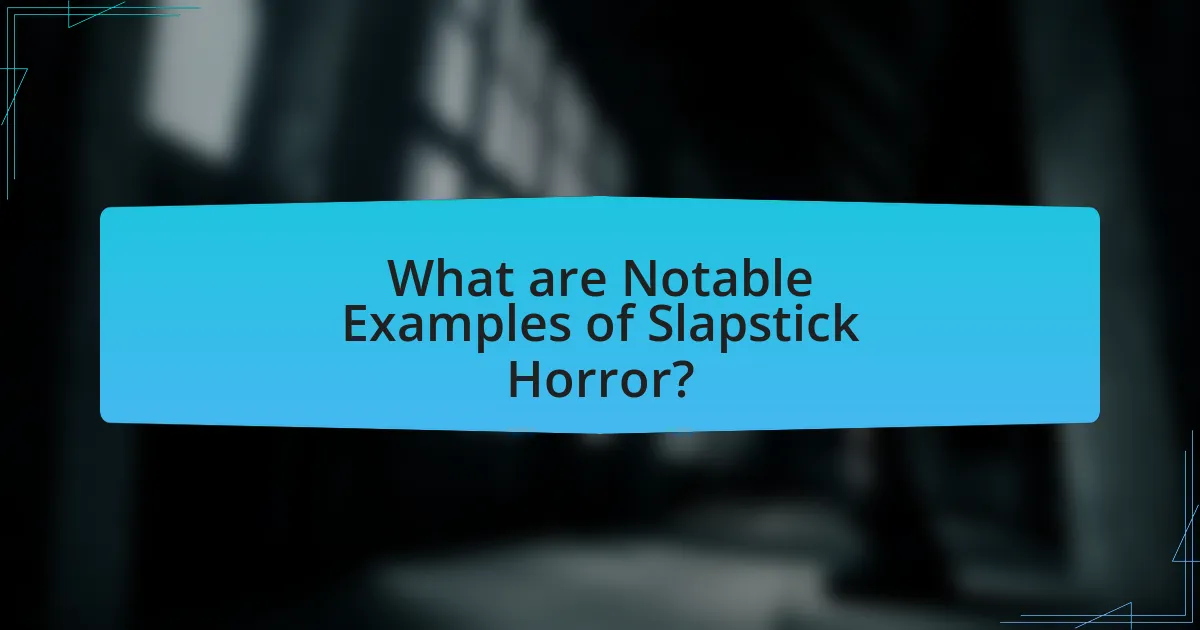
What are Notable Examples of Slapstick Horror?
Notable examples of slapstick horror include “Evil Dead II,” “Shaun of the Dead,” and “What We Do in the Shadows.” “Evil Dead II,” directed by Sam Raimi, combines physical comedy with horror elements, showcasing exaggerated gore and humorous situations. “Shaun of the Dead,” directed by Edgar Wright, blends zombie horror with comedic moments, using slapstick to enhance the absurdity of the apocalypse. “What We Do in the Shadows,” directed by Jemaine Clement and Taika Waititi, employs slapstick humor in a mockumentary format, depicting the mundane lives of vampires with comedic flair. These films exemplify how slapstick can effectively intersect with horror, creating a unique viewing experience.
Which films exemplify the blend of slapstick and horror?
Films that exemplify the blend of slapstick and horror include “Abbott and Costello Meet Frankenstein,” “The Evil Dead II,” and “What We Do in the Shadows.” “Abbott and Costello Meet Frankenstein” combines comedic elements with classic horror monsters, showcasing physical comedy alongside spooky scenarios. “The Evil Dead II” features over-the-top slapstick humor intertwined with horror themes, creating a unique viewing experience. “What We Do in the Shadows” employs mockumentary style to deliver both laughs and scares, effectively merging the two genres. These films demonstrate how slapstick can enhance horror by providing comedic relief while maintaining suspense.
What are the key scenes that highlight this intersection in these films?
Key scenes that highlight the intersection of slapstick and horror in films include the comedic chase sequences in “Shaun of the Dead,” where characters navigate zombie encounters with exaggerated physical humor, and the absurdly humorous death scenes in “What We Do in the Shadows,” which blend slapstick elements with horror tropes. In “Evil Dead II,” the protagonist’s frantic and exaggerated reactions to supernatural threats create a blend of terror and comedy, showcasing how physical comedy can coexist with horror elements. These scenes exemplify how filmmakers effectively use humor to alleviate tension while simultaneously engaging with horror themes.
How have these films influenced the genre as a whole?
These films have significantly influenced the genre by blending comedic elements with horror tropes, creating a unique subgenre that appeals to diverse audiences. This fusion allows for a juxtaposition of fear and laughter, which can enhance the emotional experience of viewers. For instance, films like “Shaun of the Dead” and “What We Do in the Shadows” have successfully integrated slapstick humor into horror narratives, leading to increased popularity and critical acclaim. This trend has encouraged filmmakers to experiment with tonal shifts, resulting in innovative storytelling techniques that challenge traditional genre boundaries. The success of these films has also inspired a new wave of horror-comedy hybrids, demonstrating their lasting impact on the genre as a whole.
What lessons can be learned from successful slapstick horror films?
Successful slapstick horror films teach the importance of balancing humor and fear to engage audiences effectively. This genre demonstrates that comedic elements can enhance the horror experience by providing relief and making the frightening moments more impactful. For instance, films like “Shaun of the Dead” successfully blend comedic timing with horror tropes, allowing viewers to connect emotionally while also being entertained. The juxtaposition of slapstick humor with horror scenarios creates a unique viewing experience that can attract a wider audience, as evidenced by the commercial success of such films.
How can filmmakers effectively balance humor and horror?
Filmmakers can effectively balance humor and horror by strategically timing comedic moments to provide relief from tension, thereby enhancing the overall impact of both genres. This technique allows audiences to experience a rollercoaster of emotions, where laughter can amplify the shock of a scare, making the horror elements more memorable. For instance, films like “Shaun of the Dead” utilize humor to create a relatable atmosphere, which contrasts sharply with the horror elements, thus intensifying the audience’s reactions. Research indicates that the juxtaposition of humor and horror can lead to increased viewer engagement, as it keeps the audience on edge, unsure of what to expect next.
What common pitfalls should be avoided in slapstick horror?
Common pitfalls to avoid in slapstick horror include failing to balance humor and horror, which can lead to a disjointed narrative. When the comedic elements overshadow the horror, the intended tension and fear can dissipate, resulting in a lack of engagement from the audience. Additionally, relying on clichés can diminish originality; for instance, overused gags or predictable scares can make the content feel stale. Another pitfall is neglecting character development, as flat characters can prevent viewers from forming emotional connections, thus undermining the impact of both comedic and horrific moments. Lastly, poor pacing can disrupt the flow; if comedic beats are too rushed or horror elements are drawn out unnecessarily, the overall experience can suffer.
What practical tips can enhance the slapstick-horror experience?
To enhance the slapstick-horror experience, incorporate exaggerated physical comedy with unexpected horror elements. This combination creates a unique atmosphere where humor and fear coexist, engaging the audience on multiple levels. For instance, using visual gags, such as a character slipping on a banana peel while being chased by a monster, effectively juxtaposes comedy with tension. Historical examples, like the film “Shaun of the Dead,” demonstrate this blend, as it successfully mixes comedic timing with horror tropes, resulting in a memorable viewing experience.

